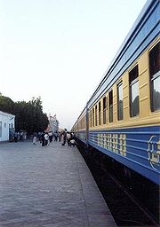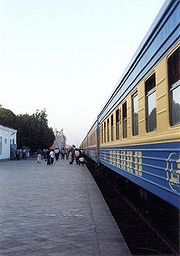
Transport in Uzbekistan
Encyclopedia
Because of low investment and poor maintenance, Uzbekistan
's overland transportation infrastructure
has declined significantly in the post-Soviet era. Air transport is the only branch that has received substantial government investment in the early 2000s, as airport
modernization projects have been undertaken. For transport in the Soviet Union, see Transport in the Soviet Union
.
 In 2005 Uzbekistan had 3,950 kilometers of rail
In 2005 Uzbekistan had 3,950 kilometers of rail
lines, about 620 kilometers of which were electrified. A large percentage of the system’s track requires major repair. The main line is the portion of the Transcaspian Railroad that connects Tashkent
with the Amu Darya
. There are rail links with Kazakhstan, Kyrgyzstan (see Trans-Caspian Railway
), Tajikistan, Afghanistan, and Turkmenistan. The Tashkent–Samarkand high-speed rail line
; a line upgraded to high speed operation is planned to open in September 2011.
The Tashkent Metro
is the only such line in Central Asia.
projects were underway in 2006. In the early 2000s, U.S. engineers improved some roads around the port of Termez
to facilitate movement of humanitarian supplies to Afghanistan
. Uzbekistan is a member country of the United Nations’ Asian Highway Network, and several national roads are designated as part of the network.
on the Amu Darya
river. Although Termez lacks modern facilities and has a shortage of spare parts, activity there has increased as conditions in neighboring Afghanistan have stabilized. Termez has been an important transfer point for humanitarian supplies entering Afghanistan.
Uzbekistan has 1,100 kilometers of inland waterways. Since the mid-1990s, commercial travel on Uzbekistan’s portion of the Amu Darya has been reduced because of low water levels.
, Lufthansa
, Transaero
, and Turkish Airlines
, and with New York
and Los Angeles
via connecting flights through Moscow
. The national airline, Uzbek Havo Yollari (Uzbekistan Airlines), flies mainly within the former Soviet Union. Fuel shortages often disrupt flight schedules from Uzbekistani airports.
Uzbekistan
Uzbekistan , officially the Republic of Uzbekistan is a doubly landlocked country in Central Asia and one of the six independent Turkic states. It shares borders with Kazakhstan to the west and to the north, Kyrgyzstan and Tajikistan to the east, and Afghanistan and Turkmenistan to the south....
's overland transportation infrastructure
Infrastructure
Infrastructure is basic physical and organizational structures needed for the operation of a society or enterprise, or the services and facilities necessary for an economy to function...
has declined significantly in the post-Soviet era. Air transport is the only branch that has received substantial government investment in the early 2000s, as airport
Airport
An airport is a location where aircraft such as fixed-wing aircraft, helicopters, and blimps take off and land. Aircraft may be stored or maintained at an airport...
modernization projects have been undertaken. For transport in the Soviet Union, see Transport in the Soviet Union
Transport in the Soviet Union
Transport in the Union of Soviet Socialist Republics was an important part of the nation's economy. The economic centralisation of the late 1920s and 1930s led to the development of infrastructure at a massive scale and rapid pace. Before the Soviet Union's collapse in 1991, there were a wide...
.
Railways

Rail transport
Rail transport is a means of conveyance of passengers and goods by way of wheeled vehicles running on rail tracks. In contrast to road transport, where vehicles merely run on a prepared surface, rail vehicles are also directionally guided by the tracks they run on...
lines, about 620 kilometers of which were electrified. A large percentage of the system’s track requires major repair. The main line is the portion of the Transcaspian Railroad that connects Tashkent
Tashkent
Tashkent is the capital of Uzbekistan and of the Tashkent Province. The officially registered population of the city in 2008 was about 2.2 million. Unofficial sources estimate the actual population may be as much as 4.45 million.-Early Islamic History:...
with the Amu Darya
Amu Darya
The Amu Darya , also called Oxus and Amu River, is a major river in Central Asia. It is formed by the junction of the Vakhsh and Panj rivers...
. There are rail links with Kazakhstan, Kyrgyzstan (see Trans-Caspian Railway
Trans-Caspian railway
The Trans-Caspian Railway is a railway that follows the path of the Silk Road through much of western Central Asia. It was built by the Russian Empire during its expansion into Central Asia in the 19th century. The railway was started in 1879, following the Russian defeat of Khokand...
), Tajikistan, Afghanistan, and Turkmenistan. The Tashkent–Samarkand high-speed rail line
Tashkent–Samarkand high-speed rail line
The Tashkent to Samarkand high-speed rail line is a , high-speed rail, connection between the two largest Uzbek cities of Tashkent and Samarkand and through four provinces: Tashkent, Sirdaryo, Jizzakh and Samarqand in Uzbekistan...
; a line upgraded to high speed operation is planned to open in September 2011.
The Tashkent Metro
Tashkent Metro
The Tashkent Metro is the rapid transit system serving the city of Tashkent, the capital of Uzbekistan. It is the only currently operating subway system in Central Asia. It was the seventh metro to be built in the former USSR, opening in 1977...
is the only such line in Central Asia.
Highways
In 2005 Uzbekistan had 84,400 kilometers of roads, about 72,000 kilometers of which were paved. The road infrastructure is deteriorating, particularly outside of Tashkent. No significant highwayHighway
A highway is any public road. In American English, the term is common and almost always designates major roads. In British English, the term designates any road open to the public. Any interconnected set of highways can be variously referred to as a "highway system", a "highway network", or a...
projects were underway in 2006. In the early 2000s, U.S. engineers improved some roads around the port of Termez
Termez
Termez is a city in southern Uzbekistan near the border with Afghanistan.Some link the name of the city to thermos, "hot" in Greek, tracing its name back to Alexander the Great. Others suggest that it came from Sanskrit taramato, meaning "on the river bank". It is the hottest point of Uzbekistan...
to facilitate movement of humanitarian supplies to Afghanistan
Afghanistan
Afghanistan , officially the Islamic Republic of Afghanistan, is a landlocked country located in the centre of Asia, forming South Asia, Central Asia and the Middle East. With a population of about 29 million, it has an area of , making it the 42nd most populous and 41st largest nation in the world...
. Uzbekistan is a member country of the United Nations’ Asian Highway Network, and several national roads are designated as part of the network.
Ports and waterways
Landlocked Uzbekistan has no seaports. Its main river port is TermezTermez
Termez is a city in southern Uzbekistan near the border with Afghanistan.Some link the name of the city to thermos, "hot" in Greek, tracing its name back to Alexander the Great. Others suggest that it came from Sanskrit taramato, meaning "on the river bank". It is the hottest point of Uzbekistan...
on the Amu Darya
Amu Darya
The Amu Darya , also called Oxus and Amu River, is a major river in Central Asia. It is formed by the junction of the Vakhsh and Panj rivers...
river. Although Termez lacks modern facilities and has a shortage of spare parts, activity there has increased as conditions in neighboring Afghanistan have stabilized. Termez has been an important transfer point for humanitarian supplies entering Afghanistan.
Uzbekistan has 1,100 kilometers of inland waterways. Since the mid-1990s, commercial travel on Uzbekistan’s portion of the Amu Darya has been reduced because of low water levels.
Pipelines
In 2006 Uzbekistan had 9,594 kilometers of natural gas pipelines, 868 kilometers of oil pipelines, and 33 kilometers of pipelines for refined products.Airports
In 2006 Uzbekistan had 34 airports with paved runways, six of which had runways longer than 3,000 meters. The largest of them, at Tashkent, is linked with European and Middle Eastern cities by direct flights of AeroflotAeroflot
OJSC AeroflotRussian Airlines , commonly known as Aeroflot , is the flag carrier and largest airline of the Russian Federation, based on passengers carried per year...
, Lufthansa
Lufthansa
Deutsche Lufthansa AG is the flag carrier of Germany and the largest airline in Europe in terms of overall passengers carried. The name of the company is derived from Luft , and Hansa .The airline is the world's fourth-largest airline in terms of overall passengers carried, operating...
, Transaero
Transaero
OJSC Transaero Airlines or simply Transaero is an airline with its head office on the grounds of Domodedovo International Airport, Domodedovsky District, Moscow Oblast, Russia. It operates scheduled and charter flights to more than 99 domestic and international destinations...
, and Turkish Airlines
Turkish Airlines
Turkish Airlines is the national flag carrier airline of Turkey, headquartered in the Turkish Airlines General Management Building on the grounds of Atatürk Airport in Yeşilköy, Bakirköy district, Istanbul...
, and with New York
New York
New York is a state in the Northeastern region of the United States. It is the nation's third most populous state. New York is bordered by New Jersey and Pennsylvania to the south, and by Connecticut, Massachusetts and Vermont to the east...
and Los Angeles
Los Ángeles
Los Ángeles is the capital of the province of Biobío, in the commune of the same name, in Region VIII , in the center-south of Chile. It is located between the Laja and Biobío rivers. The population is 123,445 inhabitants...
via connecting flights through Moscow
Moscow
Moscow is the capital, the most populous city, and the most populous federal subject of Russia. The city is a major political, economic, cultural, scientific, religious, financial, educational, and transportation centre of Russia and the continent...
. The national airline, Uzbek Havo Yollari (Uzbekistan Airlines), flies mainly within the former Soviet Union. Fuel shortages often disrupt flight schedules from Uzbekistani airports.

